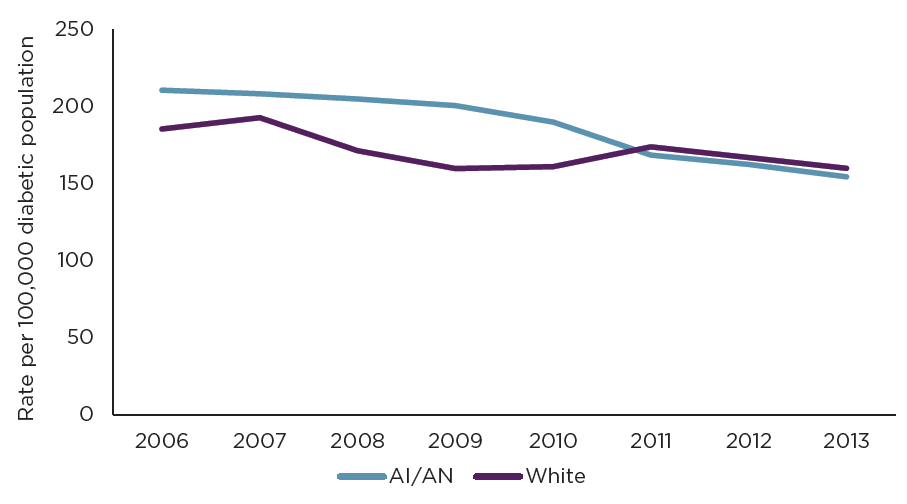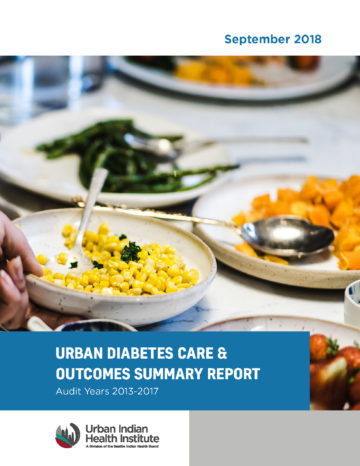In 1997, the US Congress responded to the growing burden of type 2 diabetes in American Indian and Alaska Natives (AI/ANs) by funding the Special Diabetes Program for Indians (SDPI). SDPI supports culturally-adapted and community-directed approaches to diabetes prevention, including funding the Urban Diabetes Care & Outcomes Summary Report, Audit Years 2013-2017. This document gives a snapshot of the 2017 Diabetes Audit.
Background
In 1997, the US Congress responded to the growing burden of type 2 diabetes in American Indian and Alaska Natives (AI/ANs) by funding the Special Diabetes Program for Indians (SDPI).1 SDPI supports culturally-adapted and community-directed approaches to diabetes prevention, including funding the Urban Diabetes Care & Outcomes Summary Report, Audit Years 2013-2017. SDPI programs have huge impacts on diabetes care and outcomes for AI/AN people such as the recent discovery that both new and total cases of end-stage renal disease declined in diabetic AI/ANs since 2006 (Figure 1).2 Since 2009, the Urban Indian Health Institute has analyzed diabetes data from 31 Urban Indian Health Programs that the Indian Health Service collects annually to share a comprehensive picture of diabetes healthcare in urban AI/AN communities.3 Data captured in the 2017 Audit reflects care administered in 2016.
Key Findings
The following statistics highlight key findings about the health status of diabetic urban AI/ ANs in the 2017 Audit. Each measure is based on the Government Performance and Results Act (GPRA) goals which guide assessment of diabetes-related programs. Audit results are not official GRPA results but rather serve as a evaluation metric.
Goals Exceeded
| Good Glycemic Control 55.1% of urban AI/AN patients with diabetes had an A1c < 8.0%, above the goal of 48.4% for 2017. |
| Good Blood Pressure Control Blood pressure control is defined as having blood pressure <140/90. The goal for 2017 was 63.8%. Urban AI/AN diabetic patients exceeded this goal at 78.0%. |
Goals on Track
| Nephropathy Assesment Measurements used to check for nephropathy are eGFR and UACR. In 2017, 62.4% of urban AI/AN diabetic patients had both eGFR and UACR completed, almost meeting the 2017 goal of 63.3%. |
Room for Growth
| Statin Therapy to Reduce Cardiovascular Disease (CVD) Risk 47.4% of urban AI/AN patients with diabetes were prescribed a statin, falling below the goal of 61.9% for 2017. |
| Retinopathy Screening Only 52.1% of urban AI/AN patients with diabetes had a dilated eye exam in 2017, 11% lower than the annual goal of 63.1%. |

Figure 1. Rates of End Stage Renal Disease by Race
A study by Bullock, Burrows, Narva et al. (2017) found that diabetes associated endstage renal disease (ESRD) incidence rates among AI/ANs have decreased by 28% since 2006, following the implementation of SDPI by IHS. By 2013, rates of ESRD in White and AI/AN diabetic populations were nearly equal.
Recommendations
Based on our findings of the Urban Diabetes Care & Outcomes Summary Report, Audit Years 2013-2017,[3] we recommend improvements in the following areas:
Data Collection
- Gather information on diabetes patients’ care and outcomes consistently to better identify ongoing improvements and continuing gaps.
Programmatic Recommendations
- Encourage urban diabetes patients to stay up to date on all immunizations and routine screenings.
Research
- Investigate the trends of end- stage renal disease in urban AI/ ANs to determine if the trend is similar to what has been observed in the overall AI/AN population (Figure 1).
Prevention Funding
- Invest in community efforts that increase access to dental exams, retinopathy assessment, and nephropathy assessment.
- Continue support of successful efforts for depression screening and referral of tobacco users to cessation counseling.
References
- Indian Health Services. Special Diabetes Program for Indians. Available at: https://www.ihs.gov/sdpi/.
- Ann Bullock, Nika Rios Burrows, Andrew S Narva, et al. Vital Signs: Decrease in Incidence of Diabetes-Related End-Stage Renal Disease among American Indians/Alaska Natives —
- United States, 1996–2013. Morbidity and Mortality Weekly Report. 2017;66(1):7.
- Urban Indian Health Insitute, Seattle Indian Health Board (2018). Urban Diabetes Care & Outcomes Summary Report, Audit Years 2013-2017. Seattle, WA: Urban Indian Health Institute.


